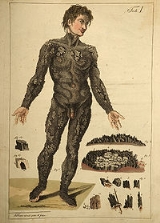
Ichthyosis hystrix
Encyclopedia
The term ichthyosis hysterix is used to describe several rare skin disorders in the ichthyosis
family of skin disorders characterized by massive hyperkeratosis
with an appearance like spiny scales. This term is also used to refer to a type of epidermal nevi with extensive bilateral distribution.
 The symptoms of Ichthyosis hystrix Curth-Macklin are similar to epidermolytic hyperkeratosis
The symptoms of Ichthyosis hystrix Curth-Macklin are similar to epidermolytic hyperkeratosis
(NPS-2 type) but there is no blistering and the hyperkeratosis is verrucous or spine-like. The hyperkeratosis is brown-grey in colour and is most obvious on the arms and legs. It is a autosomal dominant condition and can be caused by errors to the KRT1 gene.
. From the history of the Lambert family the disease appears to have been an autosomal dominant condition.
near Düsseldorf where it was first discovered. Symptoms are bilateral hearing loss and spiky hyperkeratotic masses which cover the whole body though the palms and soles are less badly affected. It can be differentiated from KID syndrome which also has symptoms of deafness and ichthyosis by the different distribution of hyperkeratosis. It is an autosomal dominant condition caused by a mutation to the GJB2
gene (the same gene affected by KID syndrome).
Ichthyosis
Ichthyosis is a heterogeneous family of at least 28, generalized, mostly genetic skin disorders. All types of ichthyosis have dry, thickened, scaly or flaky skin...
family of skin disorders characterized by massive hyperkeratosis
Hyperkeratosis
Hyperkeratosis is thickening of the stratum corneum, often associated with a qualitative abnormality of the keratin, and also usually accompanied by an increase also in the granular layer...
with an appearance like spiny scales. This term is also used to refer to a type of epidermal nevi with extensive bilateral distribution.
Ichthyosis hystrix, Curth-Macklin type

Epidermolytic hyperkeratosis
Epidermolytic hyperkeratosis, is a rare skin disease in the ichthyosis family affecting around 1 in 250,000 people.It involves the clumping of keratin filaments.-Presentation:At birth, affected babies are called "enfant...
(NPS-2 type) but there is no blistering and the hyperkeratosis is verrucous or spine-like. The hyperkeratosis is brown-grey in colour and is most obvious on the arms and legs. It is a autosomal dominant condition and can be caused by errors to the KRT1 gene.
Ichthyosis hystrix, Lambert type
Also known as Ichthyosis hystrix gravior or porcupine man. This disease is characterised by spiny scales which cover the entire body except the face, genitals, palms and soles. The only known cases were in Edward Lambert (known as the porcupine man) who was exhibited in front of the Royal Society in London in 1731 and three generations of his descendants. No cases of this disease are now known though some experts believe that it may have been a type of epidermolytic hyperkeratosisEpidermolytic hyperkeratosis
Epidermolytic hyperkeratosis, is a rare skin disease in the ichthyosis family affecting around 1 in 250,000 people.It involves the clumping of keratin filaments.-Presentation:At birth, affected babies are called "enfant...
. From the history of the Lambert family the disease appears to have been an autosomal dominant condition.
Hystrix-like ichthyosis with deafness syndrome
HID syndrome is also known as Ichthyosis hystrix, Rheydt type after the German city of RheydtRheydt
Rheydt is a borough of the German city Mönchengladbach, located in the west of North Rhine-Westphalia. Until 1918 and then again from 1933 through 1975 it was an independent city....
near Düsseldorf where it was first discovered. Symptoms are bilateral hearing loss and spiky hyperkeratotic masses which cover the whole body though the palms and soles are less badly affected. It can be differentiated from KID syndrome which also has symptoms of deafness and ichthyosis by the different distribution of hyperkeratosis. It is an autosomal dominant condition caused by a mutation to the GJB2
GJB2
Gap junction beta-2 also known as connexin-26 is a protein that in humans is encoded by the GJB2 gene. Defects in this gene lead to the most common form of congenital deafness in developed countries, called DFNB1, also known as Connexin 26 deafness or GJB2-related deafness.- Function :Gap...
gene (the same gene affected by KID syndrome).

